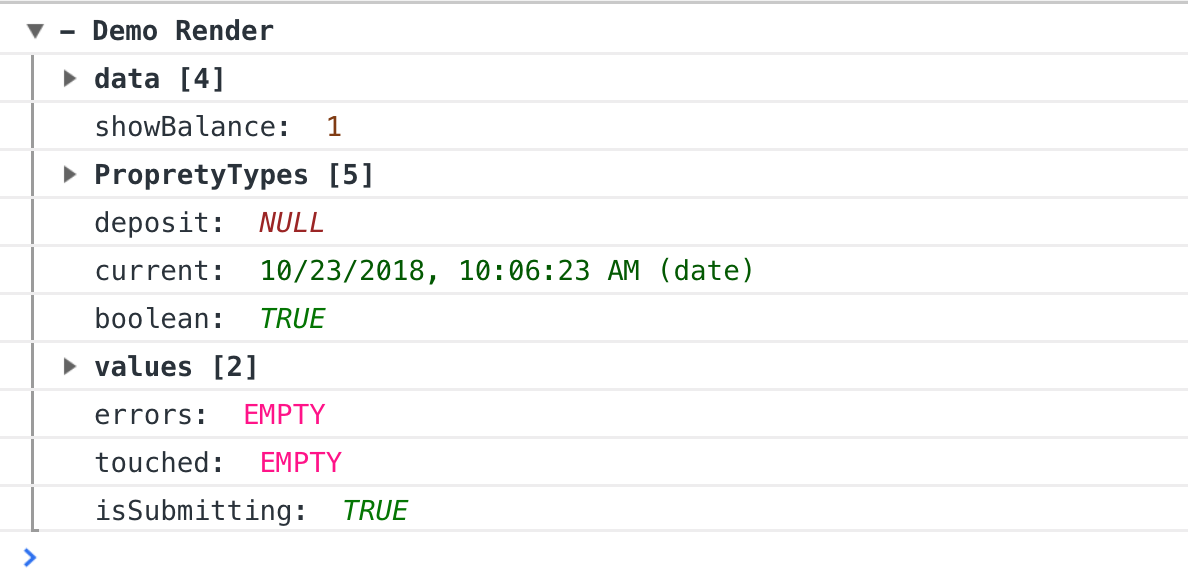console-logging
Turn your plain console form this
To this,
A wrapper around usual console.log() - This is a utility that I use along with frontend React project to visualize complex objects. You can use the console logs for debugging and easily turn them on/off by setting the logging level and have logs that are clear to read.
Install
npm i clean_logs
const logging = require("clean_logs");
const logger = logging.logger;
or ES6 import
import {LOGGING_LEVELS, logger } from 'clean_logs';
The use case of logger.setLevel() is in production environment, just switch on/off the logger and you have extra debug logs! So remember to include logger.xyz() during app development.
logger.setLevel(logging.LOGGING_LEVELS.CRITICAL)
logger.setLevel("CRITICAL") // Supports string levels: CLEAR, DEBUG, DEBUGDATA, WARNING, ERROR,
// or get level from environment variable
logger.setLevel(process.env.LOGGING_LEVEL) // process.env.LOGGING_LEVEL = "CLEAR|DEBUG|DEBUGDATA|WARNING|ERROR"
logger.error("Transaction fail, transaction id 1") // No output
logger.setLevel(logging.LOGGING_LEVELS.ERROR)
logger.error("Transaction fail, transaction id 1") // Output 'Transaction fail, transaction id 1'
// multi-args is supported with any combination of strings, objects, arrays or functions.
logger.error("Hi", "I am", "an error") // Output 'Hi I am an error'
You have 5 log type clear, debug, debugdata, warning, error. They all have the same great formating but each have some unique diferences. This is how a console.log fo this.props on a React App looks
Exemple:
import React, { Component } from 'react';
import { LOGGING_LEVELS, logger } from 'clean_logs';
logger.setLevel(LOGGING_LEVELS.DEBUG);
class Demo extends Component {
componentDidMount() {
console.log(this.props);
logger.debug('Demo Render', this.props);
}
render() {
return <div>Test</div>;
}
}
export default Demo;
If you pass a string as one of the parameters clean_logs will use it as the title of the group. It groups any object or arrays every type is displayed with a unique color and style,
- Arrays or Objects will be grouped and the leght of the objects added to the label
- Functions are DarkCyan someFuntion().
- Numbers are SaddleBrown and italic 100.
- string are blue SomeString
- undefined are Chocolate and italic UNDEFINED
- null are Brown and italic NULL
- dates are DarkGreen 10/10/2018
- moment object is ForestGreen and formated as lll 10/10/2018
- EMPTY are DeepPink EMPTY
1 logger.debug('Demo Render Title Here', this.props);
2 logger.debug(this.props, 'Demo Render Title Here');
3 logger.debug(this.props, 'Demo Render Title Here', {
4 a: 100,
5 x: 'more messages',
6 })
Lines 1 and 2 generated the same output title on the to of the group and because we only have one object or array the group is open by default
Line 3 generates a title on the top and each object is on a separated group with a number indication the leght of the object.
Same as logger.debug but it strips out any function from the output, good for when you are debuging only the data in the console.
Same as logger.debug, any strings parameters will be added to the top of the group with orange or red label, the group data will default to a close group.

The color label can be open to show a trace for you to find out where the console.log was called from, it is not a very clean trace but I still find it usefull.
MIT




